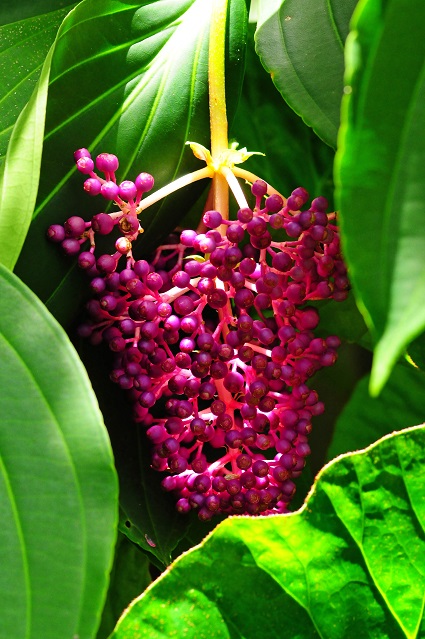
Medinilla myriantha is more commonly called Malaysian Orchid or Malaysian Grapes. This “shrub” has foliage that is dark green and has light green veins that that reach approximately one foot long. This plant produces light pink bracts (flowers) that may pop up at any time of the year. The flowers grow in clusters that resemble a bushel of grapes, before blooming. Malaysian Orchid is attractive to bees, butterflies, and birds. It is cold hardy for a tropical plant (as low as 40 degrees Fahrenheit) and does well in zones 10 and higher. It can grow to be 6 feet tall and spread out to 6 feet. The Medinilla myriantha does well in the ground and in containers. Given the right conditions and care, it can also be a great house plant.
Malaysian Orchid is not a true orchid at all. However, it is considered a “semi-epiphyte,” which gives it some of the same growing tendencies as orchids (which are true epiphytes). Malaysian Orchids are sometimes found growing in the wild tucked into trees, but you can grow them in pots if you provide the right potting medium. The soil must be very loose, allowing water to drain easily. Most growers recommend adding about 30% orchid potting mix to regular potting soil to keep it from getting overly compact.
Malaysian Orchid requires bright indirect light. In the summer, you can move Malaysian Orchids outdoors to live in the shade; try planting it in a hanging basket and suspend it from a tree to best enjoy the dangling flower panicles. Remember that this plant requires high humidity to thrive and flower, so if you live in areas with muggy summers, you’ll have the most luck. In drier areas, like the Southwest, you may need to use a greenhouse. In zones 10/11 you can grow this plant outdoors year-round; everyone else will need to move it indoors for the cooler months. Ideal winter conditions are temperatures in the 60s with continued good humidity. Set it in a dish of water and pebbles or mist the plant daily.
When conditions are right, Malaysian Orchid can bloom throughout the year, but don’t worry if you don’t see flowers for a few months. This plant sometimes skips a season or even a year before flowering again. If yours never seems to flower, try adjusting the light and humidity it is receiving. Feed it with a balanced fertilizer monthly during the spring and summer.
Related Articles & Free Email Newsletter
Plant Profile – Bananas Offer Versatility in Any Landscape
Plant Profile – Plumerias Are A Beautiful and Fragrant Tree




Comment here